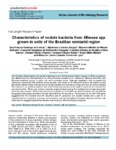Por favor, use este identificador para citar o enlazar este ítem:
http://www.alice.cnptia.embrapa.br/alice/handle/doc/984991Registro completo de metadatos
| Campo DC | Valor | Lengua/Idioma |
|---|---|---|
| dc.contributor.author | FREITAS, A. D. S. de | pt_BR |
| dc.contributor.author | BORGES, W. L. | pt_BR |
| dc.contributor.author | ANDRADE, M. M. de M. | pt_BR |
| dc.contributor.author | SAMPAIO, E. V. de S. B. | pt_BR |
| dc.contributor.author | SANTOS, C. E. de R. e S. | pt_BR |
| dc.contributor.author | PASSOS, S. R. | pt_BR |
| dc.contributor.author | XAVIER, G. R. | pt_BR |
| dc.contributor.author | MULATO, B. M. | pt_BR |
| dc.contributor.author | LYRA, M. do C. C. P. de | pt_BR |
| dc.date.accessioned | 2014-04-23T11:11:11Z | pt_BR |
| dc.date.available | 2014-04-23T11:11:11Z | pt_BR |
| dc.date.created | 2014-04-23 | pt_BR |
| dc.date.issued | 2014 | pt_BR |
| dc.identifier.citation | African Journal of Microbiology Research, v. 8, n. 8, p. 788-796, Feb., 2014. | pt_BR |
| dc.identifier.issn | ISSN 1996-0808. | pt_BR |
| dc.identifier.uri | http://www.alice.cnptia.embrapa.br/alice/handle/doc/984991 | pt_BR |
| dc.description | The Brazilian Northeastern dry forest (Caatinga) is one of the diversification centers of Mimosa species. We determined the characteristics of native rhizobia isolates from nodules of Mimosa tenuiflora and Mimosa paraibana grown in pots with soils collected under Caatinga vegetation and compared the restriction ribosomal DNA profiles of the isolates with those of 16 reference strains. All plants formed abundant indeterminate nodules and all nodule isolates formed fast growing colonies. No colony altered the medium to an alkaline reaction and most of them produced low or medium amounts of extracellular polysaccharides. White and creamy colonies predominated among the isolates but orange and green colonies were present. Differences among the isolates from the Mimosa species tested are indicated by the greater phenotypic diversity of those obtained from M. tenuiflora. The analysis of the 16S rDNA gene suggests that the isolates from M. tenuiflora and M. paraibana are closely related and closer to B-rhizobia than to α-rhizobia. However, the similarity with all the tested B-rhizobia reference strains was relatively low suggesting that the isolates may belong to different bacteria species. | pt_BR |
| dc.language.iso | eng | eng |
| dc.rights | openAccess | eng |
| dc.subject | Biological nitrogen fixation | pt_BR |
| dc.subject | Diversidade | pt_BR |
| dc.subject | Rhizobia | pt_BR |
| dc.subject | Wild tree legumes | pt_BR |
| dc.subject | Diversity | pt_BR |
| dc.subject | Fixação biológica de nitrogênio | pt_BR |
| dc.subject | Leguminosa arbórea selvagem | pt_BR |
| dc.subject | Soil bacteriology | pt_BR |
| dc.title | Characteristics of nodule bacteria from Mimosa spp grown in soils of the Brazilian semiarid region. | pt_BR |
| dc.type | Artigo de periódico | pt_BR |
| dc.date.updated | 2019-05-29T11:11:11Z | pt_BR |
| dc.subject.thesagro | Leguminosa | pt_BR |
| dc.subject.thesagro | Bacteriologia do solo | pt_BR |
| riaa.ainfo.id | 984991 | pt_BR |
| riaa.ainfo.lastupdate | 2019-05-29 -03:00:00 | pt_BR |
| dc.identifier.doi | DOI: 10.5897/AJMR2013.6518. | pt_BR |
| dc.contributor.institution | WARDSSON LUSTRINO BORGES, CPAF-AP; GUSTAVO RIBEIRO XAVIER, CNPAB; BRUNO MELLO MULATO, CNPAB. | pt_BR |
| Aparece en las colecciones: | Artigo em periódico indexado (CPAF-AP)  | |
Ficheros en este ítem:
| Fichero | Descripción | Tamaño | Formato | |
|---|---|---|---|---|
| CPAFAP2014CharacteristicsofnodulebacteriafromMimosaspp1.pdf | 980,56 kB | Adobe PDF |  Visualizar/Abrir |









